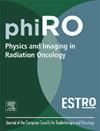多参数磁共振成像对高危软组织肉瘤放疗反应的评价:一项初步研究
IF 3.3
Q2 ONCOLOGY
引用次数: 0
摘要
背景与目的软组织肉瘤(STS)是一种罕见的间充质肿瘤,临床上尚没有有效的定量磁共振成像(qMRI)参数。本研究探讨了局部高风险STS在新辅助血管生成抑制(口服帕唑帕尼)和放疗期间和之后qMRI参数的可重复性及其与组织病理学的关系。材料和方法对15例患者的qMRI参数,包括表观扩散系数(ADC)、体积传递常数(Ktrans)和T2松弛时间,在基线(B1和B2)、新辅助治疗和术前分别获得两次。对于所有三个参数,确定每个肿瘤的平均值。然后根据B1和B2的平均值评估重复性系数(RC或%RC)。估计混合模型来研究组织病理学活细胞百分比与ADC平均值的基线绝对变化(ΔqMRI)以及T2和Ktrans在每个时间点的基线变化百分比(%ΔqMRI)之间的关系。结果ADC的RC值为0.17 × 10-3 mm2/s, T2和Ktrans的RC值分别为5%和65%。平均ADC和T2的变化在各时间点均呈上升和下降趋势,而平均Ktrans以下降为主。ADC平均值为ΔqMRI, T2平均值为%ΔqMRI, Ktrans平均值为%ΔqMRI,与活细胞百分比无统计学意义关联。本初步研究报告了ADC和T2的重复性系数相对较低,而Ktrans的重复性系数较高,并且在15例STS患者中显示了qMRI参数的异质性变化,但这些参数与活细胞百分比之间没有相关性。本文章由计算机程序翻译,如有差异,请以英文原文为准。
Multiparametric magnetic resonance imaging for radiotherapy response evaluation in high-risk soft tissue sarcoma: A pilot study
Background and purpose
Soft tissue sarcomas (STS) are rare mesenchymal tumors for which no clinically validated quantitative magnetic resonance imaging (qMRI) parameters exist yet.
This study explores repeatability and association with histopathology of qMRI parameters during and after neo-adjuvant angiogenesis inhibition (oral pazopanib) and radiotherapy for localized, high-risk STS.
Materials and methods
For fifteen patients, qMRI parameters, including apparent diffusion coefficient (ADC), volume transfer constant (Ktrans) and T2 relaxation times were acquired twice at baseline (B1 and B2), twice during neo-adjuvant treatment and pre-surgery. For all three parameters, the mean was determined per tumor. Subsequently, repeatability coefficient (RC or %RC) was assessed from B1 and B2 mean values. Mixed models were estimated to study the association between percentage viable cells from histopathology and absolute change from baseline (ΔqMRI) for ADC mean and percentage change from baseline (%ΔqMRI) for T2 and Ktrans at each time point.
Results
RC was 0.17 × 10-3 mm2/s for ADC and %RC was, 5 % and 65 % for T2 and Ktrans, respectively.
The changes in mean ADC and T2 showed both increases and decreases at each timepoint, whereas mean Ktrans predominantly showed decreases. ΔqMRI for ADC mean, %ΔqMRI for T2 mean and %ΔqMRI for Ktrans mean showed no statistically significant association with % viable cells.
Conclusion
This pilot study reported relatively low repeatability coefficients for ADC and T2 and a higher repeatability coefficient for Ktrans and showed heterogeneous changes in qMRI parameters in fifteen STS patients, however with no association between these parameters and percentage viable cells.
求助全文
通过发布文献求助,成功后即可免费获取论文全文。
去求助
来源期刊

Physics and Imaging in Radiation Oncology
Physics and Astronomy-Radiation
CiteScore
5.30
自引率
18.90%
发文量
93
审稿时长
6 weeks
 求助内容:
求助内容: 应助结果提醒方式:
应助结果提醒方式:


